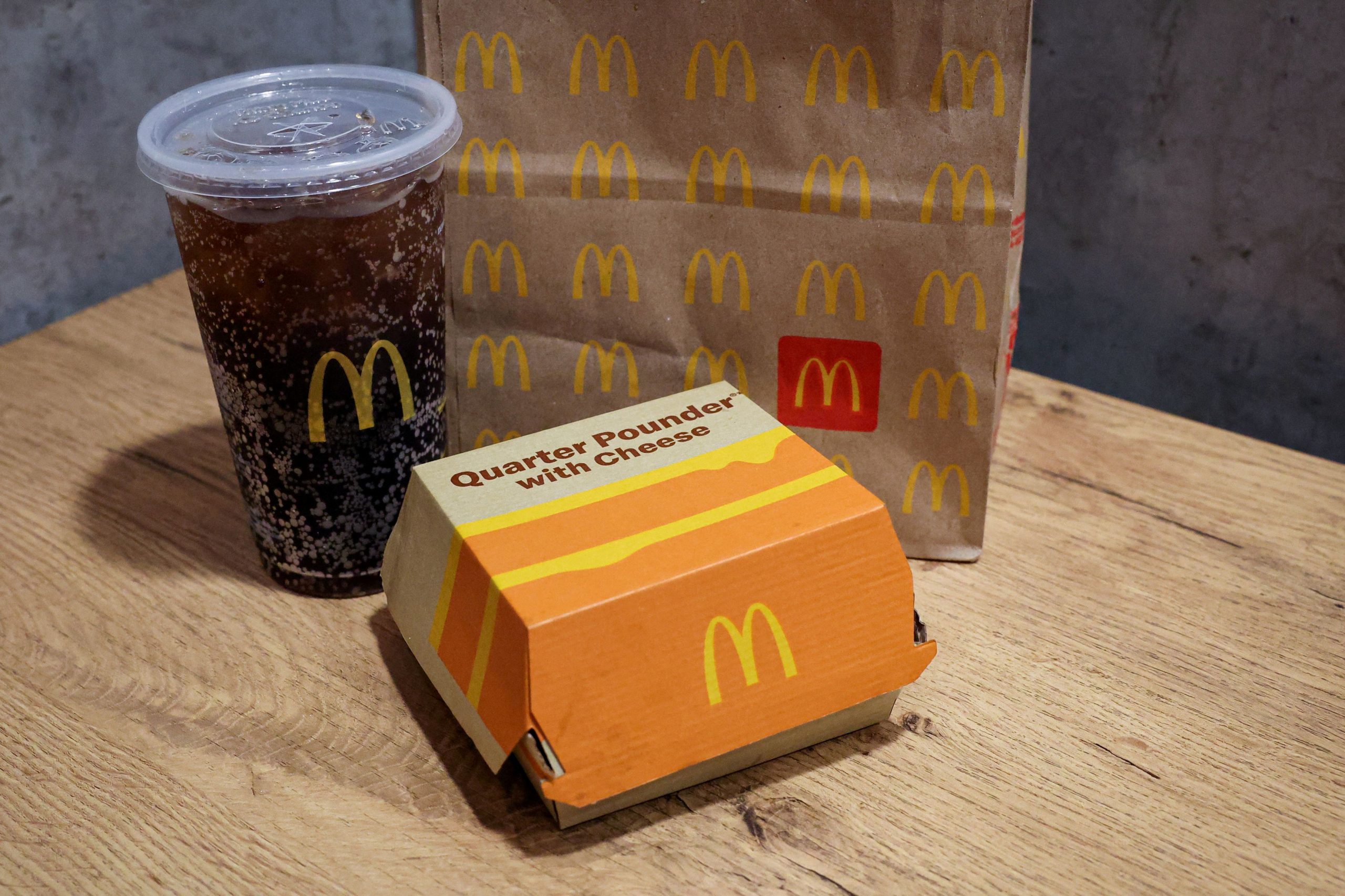Federal health officials have linked an E. coli outbreak to McDonald’s Quarter Pounders sold in several states.
One person from Colorado has died and dozens of others have been sickened in 10 states, the Centers for Disease Control and Prevention said. The agency said the first illness was reported in September.
Here’s what McDonald’s customers should know about the outbreak:
What was the cause of the outbreak at McDonald’s?
McDonald’s said that a subset of illnesses might be linked to slivered onions used in the Quarter Pounder and that the onions are sourced from a single supplier that served three distribution centers.
Colorado health officials said that the Food and Drug Administration’s early read was that onions were the outbreak’s source and that the slivered onions are used primarily on Quarter Pounders and not other McDonald’s menu items. The Agriculture Department is also looking into the burgers’ beef patties, state officials said.
The company said it paused distribution of slivered onions to stores in certain areas. Local restaurants were told to remove the product from their supply.
Taylor Farms, the produce company that supplied the onions, said it was cooperating with CDC and the Food and Drug Administration, and has removed from the market yellow onions produced at its Colorado facility. Taylor said it tests its products for pathogens and hasn’t found traces of E. coli.
Restaurant supplier U.S. Foods sent a notice to customers informing them that Taylor had recalled several types of peeled and diced yellow onions due to potential contamination, and advising restaurants to stop using the products.
McDonald’s has temporarily pulled the Quarter Pounder from restaurants in Colorado, Kansas, Utah and Wyoming, in addition to portions of Idaho, Iowa, Missouri, Montana, Nebraska, Nevada, New Mexico and Oklahoma.
Other beef products, including McDonald’s Cheeseburger, Hamburger, Big Mac, McDouble, and Double Cheeseburger aren’t affected, the company said.
How many people have been infected with E. coli?
Forty-nine people have been infected with a strain of E. coli with dates of illness ranging from Sept. 27 to Oct. 11, the CDC said. Ten people have been hospitalized, including a child who developed a serious condition that can cause kidney failure.
The person who died in the outbreak was an older adult in Colorado who had underlying conditions, state and federal health authorities said Tuesday. Most of the sick people are from Colorado or Nebraska.
The CDC said the tally of sick people is likely higher than the reported figure, in part because many recover without medical treatment and aren’t tested for the bacteria. It also can take up to four weeks to determine whether a sick person is connected to an outbreak.
Official tallies are updated periodically based on information that public-health officials gather.
McDonald’s said most states and menu items aren’t affected. “We are working quickly to return our full menu,” in affected areas, McDonald’s U.S. President Joe Erlinger said.
It isn’t clear whether the problem extends beyond McDonald’s, which can use a number of suppliers to source products for its restaurants.
What is E. coli?
Escherichia coli, or E. coli, is a common bacteria that can be found in the guts of people and animals, as well as in the environment, water and food.
Most E. coli are harmless, but some strains can cause severe illness, including urinary-tract infections and pneumonia. A type of E. coli known as Shiga toxin-producing E. coli, which can be spread via contaminated food and water, can cause serious and even life-threatening infections.
What are the symptoms of an E. coli infection?
Foodborne E. coli infections can cause stomach cramps, vomiting and diarrhea that is often bloody. Symptoms often start within three to four days after ingesting the bacteria, but it can take up to 10 days for symptoms to appear.
Most people recover within a week without treatment, according to the CDC, but in some cases, infections can lead to severe dehydration and life-threatening kidney problems. Signs of a dangerous kidney problem include a decrease in urination and reduced alertness.
Young children, older adults and people with weakened immune systems are at increased risk of severe disease.
How can a suspected E. coli illness be treated? And can you prevent infection?
There isn’t a specific treatment for foodborne E. coli. Anyone with diarrhea or vomiting should drink plenty of fluids to stay hydrated. Antibiotics aren’t recommended for Shiga toxin-producing E. coli and can make infections worse.
For people experiencing severe symptoms of a suspected E. coli infection, health officials recommend seeing a doctor and telling them what they ate. Hospitalization might be necessary to monitor the infection.
In rare cases, patients might need intravenous fluids and kidney dialysis.
Food businesses and people who handle food for a living have an important role to play in preventing the spread of foodborne infections by following proper hygiene and food-safety practices, public-health officials say. But consumers can protect themselves, too.
Avoid recalled products, wash your hands often and follow food-safety guidelines, the CDC says. That includes washing your utensils and countertops well, keeping raw meat products separate and cooking foods to the right temperature.
“Always do salads before you do meat. Make sure you wash your hands after you handle meat. Never give an undercooked hamburger to a child. Never,” said Dr. Cynthia Sears, an infectious-disease expert at Johns Hopkins University.
How do public-health officials identify an outbreak of a foodborne disease?
Some foodborne illnesses including Shiga toxin-producing E. coli are known as notifiable diseases, which healthcare providers must report to local or state public-health officials. The information can then provided to the CDC. The agency conducts surveillance of foodborne illnesses across the country, monitoring trends and potential outbreaks.
The CDC said it was first contacted on Oct. 10 by public-health officials about an increase in E. coli cases in Colorado. The CDC investigated and discovered that people in other states had recently been sickened by E. coli with the same DNA fingerprint as the one detected in Colorado. That suggested an outbreak involving several states, said Laura Gieraltowski, an epidemiologist with CDC’s foodborne-diseases division.
“People that are sick with the same DNA fingerprinted strain of a bacteria are more likely to have gotten sick from the same source,” Gieraltowski said.
How common are foodborne illnesses?
About 48 million people are sickened by foodborne diseases including E. coli every year, the CDC said. About 3,000 people die because of such illnesses.
Some foodborne infections including those caused by Shiga toxin-producing E. coli and the parasite Cyclospora increased in 2023 compared with 2016-18, the CDC said. The rise might be because of improved detection of these diseases, the agency said. But factors including climate change, intensive farming practices and the increasing complexity of food supply chains have been linked to the rise of some foodborne illnesses, studies suggest.
In 2018, hundreds of people were sickened with Cyclospora linked to McDonald’s salads. Dozens of people were infected with E. coli in 2022 after eating burgers and sandwiches containing romaine lettuce at Wendy’s restaurants.
How does foodborne E. coli spread?
Cows and other livestock can be infected with E. coli, and the bug can spread to people when they eat contaminated foods such as raw or undercooked meat.
“The reason hamburgers are still the number one transmitter of this bug is because a pack of hamburgers can be made from a hundred different cows,” Sears said. Just a small amount of the bacteria can cause disease.
E. coli infections can spread in other ways, too.
People and animals infected with E. coli shed the bacteria in their feces. The feces can infect whatever it comes into contact with, such as fruits, vegetables, water or food-preparation areas.
“The water the vegetables are watered with could be fecally contaminated,” Sears said. Fertilizer containing contaminated manure is another possible culprit.
People can also spread the bacteria to others by, for instance, not washing their hands thoroughly or handling food when sick.
This explanatory article may be updated.



